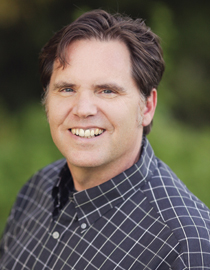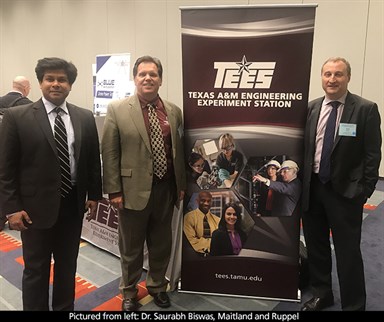 What started as a whiteboard concept nearly 20 years ago by Dr. Duncan Maitland, the Stewart & Stevenson Professor I in the Department of Biomedical Engineering at Texas A&M University, could soon turn into a revolutionary product for the medical industry for treating vascular problems like aneurysms.
What started as a whiteboard concept nearly 20 years ago by Dr. Duncan Maitland, the Stewart & Stevenson Professor I in the Department of Biomedical Engineering at Texas A&M University, could soon turn into a revolutionary product for the medical industry for treating vascular problems like aneurysms.
From his federally funded research on special plastics from the National Institutes of Health (National Institute of Biomedical Imaging and Bioengineering and National Institute of Neurological Disorders and Stroke), National Science Foundation, Department of Energy and other sources, Maitland has created a peripheral vessel occlusion device, called polyurethane-based shape memory polymer foams (SMPs). Out of the 20 years of work, the peripheral occlusion device was the first to be filed for a 510(K) clearance in the first quarter of 2017. A 510(K) is a premarket submission made to the Food and Drug Administration (FDA) to demonstrate that the device to be marketed is at least as safe and effective as a legally marketed device by the FDA.
“While a filing is no guarantee of approval to market and sell human devices, the technical and commercial distance traveled in the last 20 years is significant,” Maitland said. “The demonstrated benefit of using the shape memory polymer devices in humans and the wide adoption of technology in multiple clinical fields are two of the biggest hurdles remaining.”
Maitland said his device made of SMPs could provide doctors with a more effective and less risky method for treating aneurysms – blood-filled, balloon-like bulges in the walls of a blood vessel that can rupture and cause neurological damage that is debilitating or even fatal, especially when near the brain. Cerebral aneurysm ruptures occur in 30,000 people per year in the United States, and nearly 75 percent of those patients can either die or become neurologically debilitated. Maitland hopes his research will mean a much better outcome for patients.
“We develop vascular occlusion devices based on porous shape memory polymers. The goal in occlusion is to create controlled blood clots that block off the target volume (e.g., aneurysm) and not the healthy vessels nearby,” he said. “Existing occlusion devices, regardless of the location in the body that they target (e.g., cerebrovascular aneurysm, peripheral vessels feeding tumors and abdominal aortic aneurysms), rely on metal devices to fill volume and create foreign body surface area for clotting.”
Maitland said a dominant metal device category is embolic coils, which are spring-like devices where metal is wound around a metal or polymer wire. For all metal devices, the body is asked to clot and occlude around a relatively low percentage of metal-filled volume with a relatively low surface area. Not surprisingly, one of the main problems with metal embolic devices is that they only partially work because the target volume is not, or only partially, occluded to the point of requiring retreatment.
“Our shape memory polymer foams are delivered as compact devices that activate and expand once deployed into the body to fill a large percentage of the target volume with a porous, high-surface area clotting scaffold. Thus, for the shape memory polymer devices we achieve larger volume fills and much larger surface areas that result in superior filling and clotting,” Maitland said. “Also, during testing, the high surface area polymers result in a long-term healing response that is not observed with the metal devices. So far, in pre-clinical trials the shape memory polymer foams are superior to metal devices for both short and long-term clinical outcomes.”
Test results have also revealed SMP foams promote long-term health of the areas of the blood vessel affected by the aneurysm, reducing the chances of the aneurysm reforming, which is shown by the formation of the types of cells and tissue that lead to a more stabilized healing.
In addition to demonstrating the promotion of an aggressive healing response in aneurysms, the SMP foams developed by Maitland and his team are showing strong signs of biocompatibility – their ability to be accepted by the body. In fact, the foams are outperforming other FDA-approved materials used in blood vessels. This means less inflammation in the area, which can inhibit the healing process. Typically, foreign objects implanted in the body trigger an inflammatory response as the body attempts to reject them, but the SMP foams used by Maitland show minimal inflammation once they are inserted into the aneurysm.
 This research is drawing the attention of others as well. Shape Memory Medical, a company founded by Maitland, with industry veteran Ted Ruppel as CEO, was selected as one of the top 40 Best University Startups of 2017, and was featured at the National Council of Entrepreneurial Tech Transfer’s University Startups Conference and Demo Day in April.
This research is drawing the attention of others as well. Shape Memory Medical, a company founded by Maitland, with industry veteran Ted Ruppel as CEO, was selected as one of the top 40 Best University Startups of 2017, and was featured at the National Council of Entrepreneurial Tech Transfer’s University Startups Conference and Demo Day in April.
“It was a great honor to be recognized as a top university startup,” Maitland said. “I am a strong believer of making an impact with research in addition to the students that we train and papers that we publish.
“I am such a fan of commercial technology translation that I was the founding director of the Commercialization and Entrepreneurship Office in (the Texas A&M Engineering Experiment Station) TEES,” he said. “I am thrilled with the opportunity to connect with other university startups, the National Council of Entrepreneurial Tech Transfer, and the whole community that believes in and supports academic entrepreneurism. I also personally wish to thank Dean and Vice Chancellor (M. Katherine) Banks, President (Michael) Young and Chancellor (John) Sharp for all of their support for the entrepreneurial ecosystem that the Texas A&M System is building.”
Maitland’s other funding resources include the Lawrence Livermore National Laboratory, TEES, Texas A&M and the State of Texas Emerging Technology Fund.